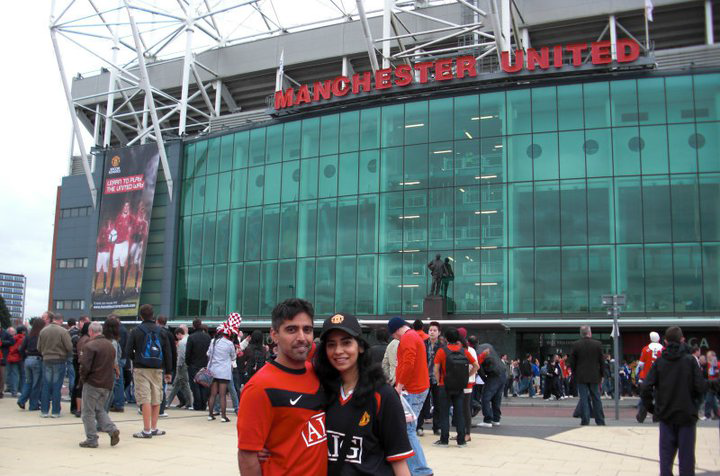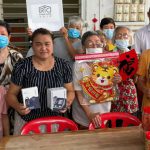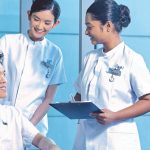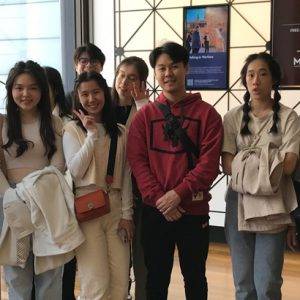Tamanna Roshan Lal started studying medicine at IMU in 1999. She completed the first two and a half years of her medical studies at the University before transferring to University of Manchester, UK to complete her training and obtain her degree. She graduated with a MB ChB from University of Manchester in 2005.  Recalling fondly of her time in IMU and University of Manchester, Tamanna said, “Studying in Malaysia at IMU was a great experience. The clinical training that I got at IMU definitely helped to prepare me for my transition to the UK. PBL’s were initially difficult for me, as I was not very good at self-studying and always needed lectures and guidance. However, after some time, you get used to the PBL system, which definitely helped when I went to study in the UK. Studying in UK was very similar to Malaysia. The IMU students were already well-equipped with good clinical skills, which made it slightly easier with the transition. The British system did demand the medical students have good communication skills, which IMU helped hone while I was in Malaysia. All in all, IMU does prepare their students well so that they are able to adapt to the system in the UK without any major problems.”
Recalling fondly of her time in IMU and University of Manchester, Tamanna said, “Studying in Malaysia at IMU was a great experience. The clinical training that I got at IMU definitely helped to prepare me for my transition to the UK. PBL’s were initially difficult for me, as I was not very good at self-studying and always needed lectures and guidance. However, after some time, you get used to the PBL system, which definitely helped when I went to study in the UK. Studying in UK was very similar to Malaysia. The IMU students were already well-equipped with good clinical skills, which made it slightly easier with the transition. The British system did demand the medical students have good communication skills, which IMU helped hone while I was in Malaysia. All in all, IMU does prepare their students well so that they are able to adapt to the system in the UK without any major problems.”
Post-graduation, Tamanna then went on to do her generalised foundation training for 2 years in the Greater Manchester region. After completion of this, she was accepted into a Paediatric Specialist training programme – also in the Greater Manchester area. However, she left this programme in 2010 to move to Oregon, USA and be with her husband.
 “The biggest difference working in the UK vs the US is that clinical medicine is practiced more in the UK while diagnostic medicine is practiced in the US. By this, I mean that in the UK, the doctor’s rely a lot on the history and examination before ordering tests, where as in the US, the doctors do a lot more tests/imaging than they need to. Also, the hours you work in the US are longer compared to the UK. Residents working in the US work about 80 – 100 hours a week, while in the UK, the junior doctors work about 60 hour week. However, it takes a longer time to specialise in the UK (up to 10 years), where as in the US you can be a specialist within 4 to 6 years”, said Tamanna who then got herself accepted into a Paediatric Residency at Sinai Hospital, Baltimore, MD in 2011. Tamanna completed her residency in 2014 and is now a Board certified Paediatrician. She was then accepted into a 3-year Medical Genetics fellowship at Johns Hopkins in Baltimore, MD. Currently, she is a second year fellow and will be the chief resident of the Medical Genetics Department for the academic year of 2016-2017. Speaking on her interest in the field of genetics, she said, “I am interested in Genetics while I was working in Burnley, a town in East Lancashire, UK. There was a big Pakistani community there, where consanguinity was very common (1st cousins marrying 1st cousins). In each family, it is extremely common to see multiple generations of inter-cousin marriages. Due to this, the babies born to future generations were born with genetic conditions that were so rare. After seeing many rare genetic conditions, I became very interested in this field and decided to specialise in it.”
“The biggest difference working in the UK vs the US is that clinical medicine is practiced more in the UK while diagnostic medicine is practiced in the US. By this, I mean that in the UK, the doctor’s rely a lot on the history and examination before ordering tests, where as in the US, the doctors do a lot more tests/imaging than they need to. Also, the hours you work in the US are longer compared to the UK. Residents working in the US work about 80 – 100 hours a week, while in the UK, the junior doctors work about 60 hour week. However, it takes a longer time to specialise in the UK (up to 10 years), where as in the US you can be a specialist within 4 to 6 years”, said Tamanna who then got herself accepted into a Paediatric Residency at Sinai Hospital, Baltimore, MD in 2011. Tamanna completed her residency in 2014 and is now a Board certified Paediatrician. She was then accepted into a 3-year Medical Genetics fellowship at Johns Hopkins in Baltimore, MD. Currently, she is a second year fellow and will be the chief resident of the Medical Genetics Department for the academic year of 2016-2017. Speaking on her interest in the field of genetics, she said, “I am interested in Genetics while I was working in Burnley, a town in East Lancashire, UK. There was a big Pakistani community there, where consanguinity was very common (1st cousins marrying 1st cousins). In each family, it is extremely common to see multiple generations of inter-cousin marriages. Due to this, the babies born to future generations were born with genetic conditions that were so rare. After seeing many rare genetic conditions, I became very interested in this field and decided to specialise in it.”  Tamanna is also currently involved in clinical research on a very rare genetic condition called Gaucher disease. Gaucher disease (GD) is a lysosomal storage disorder that results from the inherited deficiency of the enzyme glucocerebrosidase. Neuronopathic type 2 GD is the rarest, as well as the most severe and progressive form that results from this deficiency. It is so rare that only a few clinicians would ever see one case in their entire career. “Traditionally, the clinical presentation is considered to be stereotypic; however it can range anywhere from hydrops fetalis to the collodion baby phenotype to infants presenting after 6 months of life. Neurological involvement occurs very early on in the disease process, resulting in severe degeneration and death in infancy or early childhood. However in the past few decades, we are observing that these infants are living longer due to more aggressive as well as experimental interventions.”
Tamanna is also currently involved in clinical research on a very rare genetic condition called Gaucher disease. Gaucher disease (GD) is a lysosomal storage disorder that results from the inherited deficiency of the enzyme glucocerebrosidase. Neuronopathic type 2 GD is the rarest, as well as the most severe and progressive form that results from this deficiency. It is so rare that only a few clinicians would ever see one case in their entire career. “Traditionally, the clinical presentation is considered to be stereotypic; however it can range anywhere from hydrops fetalis to the collodion baby phenotype to infants presenting after 6 months of life. Neurological involvement occurs very early on in the disease process, resulting in severe degeneration and death in infancy or early childhood. However in the past few decades, we are observing that these infants are living longer due to more aggressive as well as experimental interventions.”  For her research, Tamanna interviews parents who have children with Gaucher type 2 (either alive or deceased), and asks them a lot of medical questions about their symptoms and disease process. By gathering this data, she will be able to analyse the information so that she would be able to understand the disease process better. Once she has completed my clinical genetics training in 2017, she will be doing a further fellowship in Biochemical Genetics for 1 year followed by another fellowship in Molecular Genetics (also for 1 year). She should be completing with all her subspecialisations by 2019. She will then be officially a Paediatric Biochemical and Molecular Geneticist. Tamanna intends to do clinical work in a teaching hospital as well as some clinical research. She is also considering the possibility of analysing genetic testing based on her qualifications. She also plans on doing missionary trips to third world countries to do general Paediatrics for about 1 month every year.
For her research, Tamanna interviews parents who have children with Gaucher type 2 (either alive or deceased), and asks them a lot of medical questions about their symptoms and disease process. By gathering this data, she will be able to analyse the information so that she would be able to understand the disease process better. Once she has completed my clinical genetics training in 2017, she will be doing a further fellowship in Biochemical Genetics for 1 year followed by another fellowship in Molecular Genetics (also for 1 year). She should be completing with all her subspecialisations by 2019. She will then be officially a Paediatric Biochemical and Molecular Geneticist. Tamanna intends to do clinical work in a teaching hospital as well as some clinical research. She is also considering the possibility of analysing genetic testing based on her qualifications. She also plans on doing missionary trips to third world countries to do general Paediatrics for about 1 month every year.
Her advice to the students are to continue studying in the field of medicine. “There is so much to learn out there and just because you have completed some element of your training, it does not mean you have to stop learning. My other piece of advice is, get involved in some sort of research while you are doing your training. Try to get some posters and publications under their belt. It definitely helps with self/professional development. Medicine is evolving on a daily basis, so the juniors have to make sure that they are up to date in the area of medicine they decide to specialise in.”
Learn more about Tamanna via this Presentation.









